
3JACK
Your Step Into the Foray of the Meaningless World of Golf Blogging.
This is either for the golfer who would love to just out and out bomb it or the golfer who thinks that they could harness Sadlowski's power so they could use it for serious golf tournaments and Long Drive competitions. It does have to be pretty cool for all of the PGA Tour pros to stop and watch you hit shots.
Miller probably got votes for those who really understood his prime and that 63 at Oakmont at the US Open. What probably hurt him is how long he's been away from the game and I generally think golfers are not in love with his swing.
Trevino is one of my all time faves and is probably hurt a bit by his lack of power. That being said, from tee to green he hit it about as pure, consistent and accurate as anybody. And he was absolutely deadly with a wedge in his hand.
A bit surprised how many votes he got. Tough to gauge how truly great he was since he played in a time when there were not a lot of golfers and it's hard to get a good sense of what he did so well. Was he the best ballstriker of his era? Was he long? Was he a great putter? Questions like that are rarely asked or answered. I do think some of his votes came from the crowd that were curious to see how well he would hit it with modern equipment.
Nicklaus definitely got votes for people who consider him the greatest of all time. And in my book he is until Tiger wins at least as many majors as he does. I used to think Tiger would do it with ease, now I'm not so sure. I'm starting to think that Tiger will eventually pass him, but he won't breeze by him.
At one point I would have taken Tiger's ballstriking over Nicklaus' and not blinked an eye. But now I'm not so sure. Jack was extremely long, and perhaps the longest guy on Tour. Tiger used to be arguably the longest guy on Tour, but at 33 years old it's obvious he's really nowhere close now. Jack was still arguably the longest on Tour into his 40's. Jack was much more accurate off the tee and a better long iron player, although Tiger is usually great with the long irons as well, but Jack's long iron play was off the charts. Tiger certainly has him beat in short iron play and that's probably part of what hurt Jack getting votes.
Tiger and his ballstriking is a tricky subject to get into. I think right now, for the 'best player in the world' standards it has sucked and sucked for quite awhile. But the ardent Tiger fan will think you're nuts because he is the best player in the world and in their mind he's the greatest player of all time. So how can he be a lousy ballstriker?
Again, it's by Tour standards and 'greatest player in the world' standards. I cannot really think of another #1 ranked player in the world in recent memory that struggled with their ballstriking as much as Tiger has. And to his testament, that's what makes him so amazing...he's clearly the #1 player in the world and he continually fights his golf swing in tournaments.
But it's amazing how the steadfast Tiger supporters completely neglect how great of a putter and scrambler the guy is. He's off the charts in that category as far as I'm concerned. And while he's no longer one of the Tour's longer hitters, he's playing most par 72's as par 68's. So if can hit a few drives down the middle and get some wedges in his hand, it's birdie time.
I get asked what I would do if Tiger asked for help. I would tell him to go to one of the following instructors:
- Lynn Blake
- Ted Fort
- Brian Manzella
- David Orr
- Michael Jacobs
Somebody who can customize a swing pattern for him instead of working on one particular pattern that they give pretty much every student. And furthermore, 'let them sell you' on how to improve your swing. I think a lot of Tiger's problems is he had philosophies of the golf swing that remain dear to his heart that may not suit his swing and he's unwilling to let them go.
Snead is beloved by a lot of golfers because he was such a talented ballstriker who had such a smooth, flowing swing. Plus, he was arguably the longest golfer on Tour for years. Back when I first got into the game I had the privilege of watching a video of Snead play a round of golf when he was probably in his 40's. Everything was donw the middle and LONG. Like getting on in two on 560 yard par 5's in the days of steel shafted persimmon drivers and balls that didn't travel very far. Wish I still had that video.
I think the reason why Snead got votes that Hogan didn't get was mostly a power issue. Although Hogan had ample power and was quite long for a guy his size, Snead's power and ballstriking ability would definitely be fun to watch with modernized equipment.
Can't say I blame anybody here. There's a few holes of Hogan in a Shell's Wonderful World of Golf video on YouTube where every drive is 'perfect' according to the announcers and he's pretty much all over the flagstick on every approach shot be it with a 4-wood or a wedge. I never really bought into 'Hogan wasn't long.' He wasn't the longest guy on Tour but I believe he was probably middle of the pack if not above the middle of the pack for most of his prime, which in my book is still long when you look at it from a broad point of view. Plus, here was a guy that was really lucky to be alive after that car crash and golfers thought golfing again was out of the question. And people forget that he had some years taken away from him due to his service in WWII.
I was talking to a friend of mine the other day and we started to discuss what type of clubs Hogan would be using today. We decided that saying he would use 'Hogan' clubs was a bit of a cop out. I think most golfers would probably see him using Mizuno or Miura irons. However, I actually would be a bit surprised by that. Nothing against Mr. Hogan, but many Americans from his generation did not like the Japanese due to WWII and that would probably play a factor.
My guess is that Mr. Hogan would probably look for an American company to sign with and somebody that would give him free reign to design his own clubs and do it with the utmost precision and the highest of quality. I think the irons are pretty simple, an old school blade design. The driver he would probably go to a driver that with a bit smaller clubhead, maybe 400 cc's, that was probably heavier than most. Hogan really hated lighter golf clubs. I wouldn't be completely shocked if he went to a MOI designed driver, because he was a guy that hated the hook with a passion and those drivers are hard to hook (at least for me anyway). But he would probably want to work the ball. I think Titleist or maybe Adams would be his company of choice.
3JACK






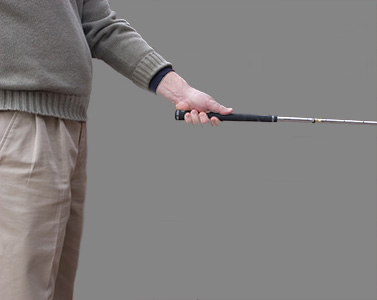
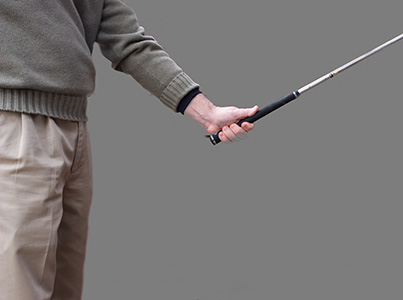
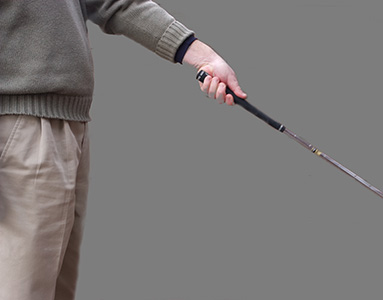

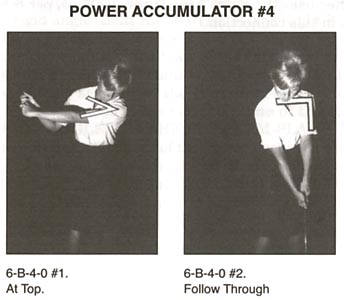
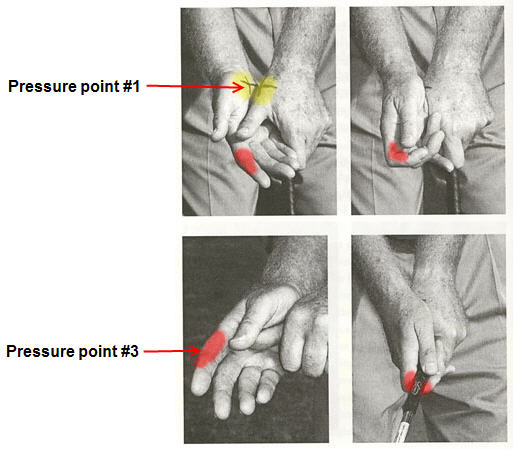



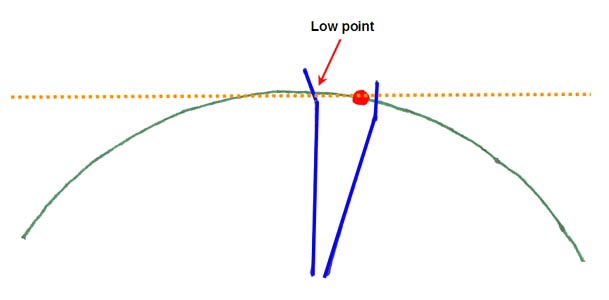


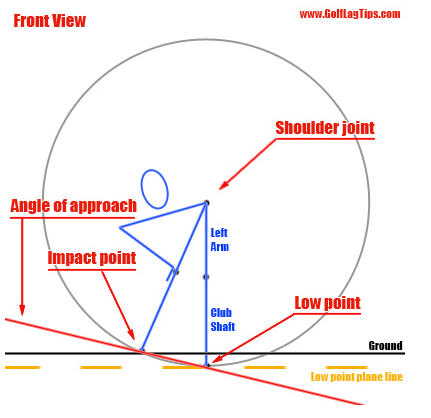 So, the clubhead now has 3-dimensional motions. From the 'overhead' view the clubhead moves on an arc. From the 'face on' view the clubhead moves in a circle. And then there's the DTL view.
So, the clubhead now has 3-dimensional motions. From the 'overhead' view the clubhead moves on an arc. From the 'face on' view the clubhead moves in a circle. And then there's the DTL view.

I still have not fully grasped the 'why's' and the 'how's' behind the 'swinging left' principle. I will say that I believe a golfer needs to get shaft lean first, with a FLW at impact and a Bent Right Wrist at impact before they start worrying about 'swinging left.'
3JACK



As the picture above shows, Tiger has a flat left wrist. The key to check for is how the left arm lines up with the clubshaft. Here's a pic of the same golfer. One with his left wrist bent on the left and the left wrist flat on the right.
As you can see, the pic on the left *looks* like he has a flat left wrist, but he actually does not. If his left wrist was flat, the shaft would be right in line with the left arm. When you look at the pic on the right, he does have that straight line relationship with the clubshaft and his left arm, thus a flat left wrist.
2. Clubhead Lag Pressure Point
This imperative goes a bit hand in hand with the #1 Imperative, a FLW (flat left wrist) at impact. You'll hear a lot about 'stressing' the shaft in your swing, that's what a clubhead lag pressure point.
A big key about TGM to remember is that if the left wrist is flat at any time in the swing, the right wrist must be bent. So for *some* golfers in order to obtain a flat left wrist at impact, they actually focuse more about keeping the right wrist bent at impact because you cannot have two bent wrists when gripping the golf club.
Now, if I were to hold the club in my hands with a flat left wrist and a bent right wrist there would be know 'clubhead lag pressure point' because the golf club has not moved. Lagging is anytime something is trailing behind. In our 'machines', you want the clubhead to be lagging behind the hands. If you swing a club and are able to have a flat left wrist and a bent right wrist at impact, you will now have some sort of clubhead lag pressure point in your right hand.
Every swing has lag to it, the key is to SUSTAIN the lag thru impact. The bad golfers will lose their lag before, if not well before, impact.
I think this imperative is a bit too overanalyzed at times. Essentially, if you can understand what a flat left wrist looks like at impact and then be able to execute a flat left wrist at impact, you'll have this imperative for you.
3. Straight Plane Lines
I think most golfers understand what 'swing plane' is to some degree. They also understand that some golfers have a more upright swing plane (i.e. Nicklaus) while some have a flatter swing plane (i.e. Hogan).
The Golfing Machine does not require a golfer to be on a certain plane nor does it say that a particular plane is better than any of the other planes. Nor does it say that a single plane swing is better than a 2 plane swing. But what it does say that is an imperative is that the plane lines are 'straight' and not 'bent.'
This video of the SmartStick training aid device by Martin Hall shows what a 'straight plane line' looks like.
Now, if the laser were to not point down on the blue plane line that Hall has in his video, that would be known as a 'bent plane' line. This is another beauty of TGM. Again, it's not saying you are better off with a 'one plane swing' or a 'two plane swing', it's just saying that you have to keep the laser on the blue plane line or you will get in trouble. One plane, two plane, upright or flat swing planes can all keep the laser on the plane line with relative ease.
The last part for today's 'lesson' is a brief understanding of the 'geometry of the circle' in the golf swing. Now, we don't need to get into in-depth analysis of the the geometric relationships in the swing, but just a very basic understanding.
From the face on view, the golf club moves in a circular motion. The lowest point the club will travel will be opposite of the left shoulder as shown in the diagram above. Inevitably, golfers have the golf ball usually towards the middle of the feet which is in back of the low point.
With this geometry, this makes the golfer hit the ball FIRST and THEN take a divot.
Why?
Because as they hit the ball they still have yet to reach the low point with their clubhead. So what happens is they hit the ball FIRST and then the clubhead goes DOWN even LOWER and takes the divot. This KJ Choi video will show it in action (take a look at the :52 mark).
The big reason why the flat left wrist is so important is that when the left wrist is bent (aka 'flipping thru impact'), this disrupts the geometry of the circle. The low point moves from the left shoulder joint to say inside the left heel and depending on how much the left wrist bends, that will change the low point.
What's funny about all of this is you will often hear high handicappers say they have been 'looking up' and that's why they cannot hit the ball. But often times it's not a case of looking up and taking their eye of the ball. It's more of a case of such a bent left wrist at impact that they have destroyed the geometry of the circle and will hit that extremely poor shot. Smartly enough, Mr. Kelley did not make 'keeping your head down' an imperative of the golf swing.
REVIEW
1. Almost countless different swings that can hit the ball with power, accuracy and consistency.
2. Because there's so many different swings, there's only 3 imperatives.
3. 3 imperatives are --- a) Flat Left Wrist at impact b) Clubhead Lag Pressure Point c) Straight Plane Lines
4. Geometry of the Circle. From the Face On view the clubhead moves in a circle. Lowest point of travel for the clubhead is the left shoulder joint. This will cause the golfer to hit the ball first, then take a divot.
Up next, 3 dimensional impact.
3JACK



This man has been a lifetime seeker of the truth. He's been involved in TGM for years. He gave me the short list of all the lessons that he had taken. He told me that he had NEVER seen himself on video with a Flat Left Wrist, until today. (hence the Amazing Change)
We worked for 45 minutes yesterday, and this is the video from the beginning of the lesson today.
7-17: Foot Loading - enabled him to get the FLW at Impact.
In his backstroke, he was getting closer to the ball. He had been told to do thousands of chips/pitches with the FLW, which doesn't hurt anyone. But, he never had the ability to keep it in a longer stroke.
His weight was so much on his toes that it changed the geometry. Getting closer to the ball discouraged Extensor Action. And, with the loss in structure, his wrist couldn't stay flat.
The circle was where his head started.
So, he would get closer to the ball, never really clearing the hip. The right elbow was inevitably on a collision course with the right kidney. Then the arm would take the detour, go around, and pull inward. The left arm became slightly bent, and the left wrist bent.
He felt like he was 10 miles from the ball at Impact, just to get the result that we did.
You can see that he has more weight up on the toes in the left hand frame versus the right hand frame.
Take a look at the differences in a couple of my swings. One from over a month ago. And here's a pic of one of my most recent impact positions.
And here's a pic of one of my most recent impact positions.
Look at the right foot. In the first pic the weight is up more towards the toes. On the second pic, the right heel is practically on the ground.
I really believe that just about any golfer who can improve their footwork can improve their ballstriking. I'm not saying it will make a 10 handicapper into a pro, but I think it will make a noticeable difference in the ballstriking improving.
The problem is that most instruction ignores footwork or teaches it incorrectly or in an incomplete fashion. Thankfully, TGM, Sevam1 and Shawn Clement do about the best job of teaching footwork I've seen.
Remember a couple of key points.
1. It's okay for the right heel to come up off the ground at impact. But it needs to come up off the ground for the right reason. If it's being lifted up off the ground, by the golfer getting the weight up on the toes, that's a problematic component. Instead, the golfer wants the right heel up off the ground if it is PULLED up off the ground from the momentum of the golf swing.
2. Like Ted mentioned, it starts at ADDRESS. The weight needs to get in the proper position of the feet at address. Sevam1 likes to talk about the pressure points being the ball of the foot and the heel. Shawn Clement talks about the arches of the feet being like 'suction cups' to the ground. Homer Kelley talks about the weight being distributed in the feet so a golfer could easily raise the toes upward if they were to choose to do so.
Some good drills for improving footwork are:
A. Hit shots with your toes raised upward.
B. Hit shots barefooted with your toes raised upward (Sam Snead Drill)
C. Stick a golf ball or a door wedge under the toes of your right foot and hit golf balls while that is under your toes.
D. Hit shots flat footed.
But the big parts are the weight distribution at address and making sure the momentum of the swing pulls the heel up off the ground instead of lifting the heel off the ground by getting the weight up on the toes. Don't be afraid to use basic, acquired and total motion to get this down.
3JACK
 Australian GSED John Furze has a nice article on putting, TGM style over at http://www.golfingmachinist.com.au/article.php?id=27 that I thought many of you may be interested in.
Australian GSED John Furze has a nice article on putting, TGM style over at http://www.golfingmachinist.com.au/article.php?id=27 that I thought many of you may be interested in.
When the putter face is at a 90 degree angle to the target line so that the toe is straight across the target line it is a Vertical Hinge
Varying the Hinge Actions will also have an effect on the length of the putt. For example, using Horizontal Hinging will give the ball more power so it can certainly be used for all lengths of putting but keep ion mind that for an extremely long Putt Horizontal Hinging would be extremely beneficial.
Horizontal Hinging will give the Purest of compression. Using Angle Hinge for a same length Putt as Horizontal Hinging you would have to give it a little more Right Arm Thrust.
This would also apply to using Vertical Hinging as once again you would have to give more Right Arm Thrust compared to the angle Hinge and even more Thrust in comparison to the Horizontal Hinge.
 You can find it at (http://golfjustlikethepros.com/GTA%20Laser%20ll.htm) for only $26.95. I'm a tad bit skeptical on how it will work. Particularly the battery life, but more of where the lasers are situated, althought I think it should be pretty darn accurate. Once I get it and try it out, I'll make a quick review of it.
You can find it at (http://golfjustlikethepros.com/GTA%20Laser%20ll.htm) for only $26.95. I'm a tad bit skeptical on how it will work. Particularly the battery life, but more of where the lasers are situated, althought I think it should be pretty darn accurate. Once I get it and try it out, I'll make a quick review of it. - I also bought the Taly. It's a highly recommended product by Lynn Blake. I was a bit skeptical of it at first since I thought it was more designed for 'swingers', but according to Lynn 'hitters' can use it as well and it also works well with 'right forearm tracing' and the 'right forearm takeaway.'
To quote Yoda:
For my students and me, the Taly is all about keeping the clubhead behind the 'clown's nose', i.e., behind the Hands and the Flat Left Wrist, through Impact and all the way into the Follow-Through (Both Arms Straight position).
If you do this, then Lag Pressure becomes a 'given', and Plane Line Tracing virtually automatic.
So if the GTA Laser II doesn't work, then hopefully the Taly will. I plan on bringing this aid to my next lesson with Ted Fort for some help with it. The Taly can be found at http://www.talygolf.com/ for about $70.
- Next month I hope to purchase the Bushnell 1500 RangeFinder w/slope. The latest versions are the Pro V2 and the Bushnell 1600, but I hope to get the 1500 on Ebay for about $250. The V2 sells for $400 (with a $50 rebate) and the 1600 goes for abotu $480. Playing up in the hilly North Georgia area, I think it's imperative to have a Rangefinder with slope. Of course, you can't use it for Tournament play. I'll have a review for that after I get one.
- Over at Brian Manzella's forum a poster asked for some 'putting tips.' Here's mine.
1. Just like the swing, there is no one way to putt the ball. Think of some of the greatest putters of all time. Locke, Crenshaw, Casper, Nicklaus, Tiger all had distinctly different putting styles. Just as it sounds crazy to listen to somebody who says you must grip the driver a certain way and swing it a certain way, it's really crazy to think you need to address the putter, grip the putter and stroke the putter a certain way because the history of the game shows differently.
2. D-Plane is alive and well in putting. It's really simpler than most golfers make it. Give me a golfer who can consistently be at 0.0 degrees to their target at impact over a guy that has inconsistent putterface angles, but a 'perfect' stroke.
3. Junk Pelz's '17" past the cup for optimal speed theory.' Mr. Geoff Mangum has thoroughly debunked this theory and speaking from experience it's a great theory if you want to hit the ball too hard.
4. Head swivel. Learn it and use it and watch your aim and speed/touch improve.
5. Learn to understand the 'fall line' and how the topography of the green tends to effect the putt. A lot of times it's easy to get fooled on the break by just reading the putt from behind the ball because the hole may not be cut properly and that can cause an illusion of it breaking one way when it actually breaks the other way. But, if you understand the fall line you can be much more accurate with your reads. Furthermore, understanding that downhill putts tend to break more and uphill putts tend to break less because of the velocity the ball is traveling.
Here, Mr. Geoff Mangum drops some knowledge.
I also suggest Mangum's 'Optimal Putting' e-book at www.puttingzone.com and David Orr's putting videos, particularly the 'How to Read Greens' video at www.orrgolf.com.
3JACK